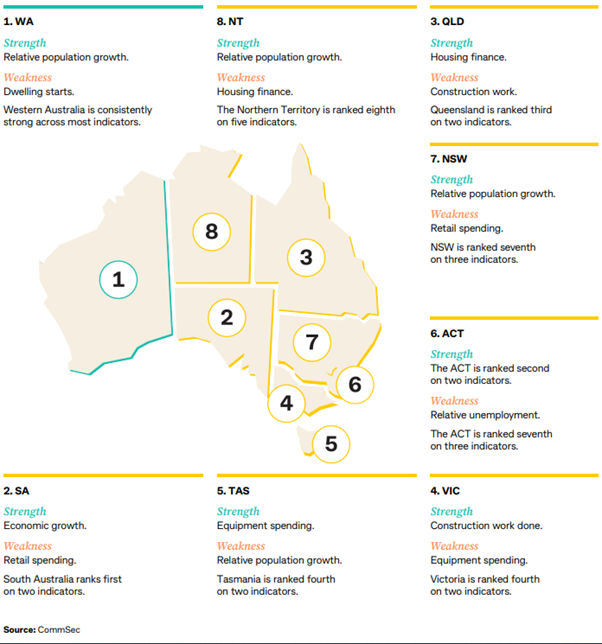Each quarter CommSec attempts to find out which state or territory is Australia’s economic leader. Now in its 15th year, the report also includes a section comparing annual growth rates for the eight key indicators across the states and territories as well as Australia as a whole, enabling comparisons in terms of economic momentum.
- Economic growth
- Retail spending
- Equipment investment
- Unemployment
- Construction work done.
- Population growth
- Housing finance
- Dwelling commencements.
Just as the Reserve Bank uses long-term averages to determine the level of “normal” interest rates; CommSec have done the same with the economic indicators. For each state and territory, latest readings for the key indicators were compared with decade averages – that is, against the “normal” performance.
Each quarter CommSec attempts to find out which state or territory is Australia’s economic leader. The report also includes a section comparing annual growth rates for the eight key indicators across the states and territories as well as Australia as a whole, enabling comparisons in terms of economic momentum.
To read the full October 2024 report click here
For the first time since July 2014, Western Australia has claimed the top spot as the country’s best-performing economy, according to the latest CommSec State of the States report.
Western Australia led in three of the report’s eight indicators: retail spending, relative unemployment and relative population growth, securing its position as the top state or territory for the quarter.
South Australia, the previous leader, dropped to second position after topping the last three surveys, while Queensland made a significant leap from fifth to third spot. Victoria, once a podium contender, slipped to fourth place, and Tasmania climbed to fifth from sixth spot.
The ACT moved down to sixth from fourth place, followed by NSW, which retained its position in seventh spot. The Northern Territory rounded out the rankings in eighth.
Overall, the economic performances of Australian states and territories are being supported by a solid job market and strong population growth at a time of higher-than-desired price inflation.
Australia’s state and territory economies have slowed as consumers respond to higher borrowing costs and price pressures. The future path will depend on the resiliency of the job market and interest rates.

The State of the States report assesses economic performance by looking at the most recent results—such as retail trade or construction—and compares that with the ‘normal experience’. And by ‘normal experience’, we define this as the decade average.
A resident of the state or territory can therefore assess whether they are experiencing relatively better economic times. Comparing states or territories on the same criteria determines which state or territory is performing the best on a certain indicator.
In addition to relative economic performance, some are also interested in economic momentum. That is, annual changes to the key indicators. A state or territory may have been under-performing, but if annual growth is strengthening, then this suggests that performance has scope to improve.
As noted above, annual growth rates are a better tool of measurement of economic performance for the Northern Territory as the small, open economy is buffeted by big projects (such as LNG construction over 2012–18 period which inflated decade averages).

Copyright © 2024 Coastline Private Wealth, All rights reserved.
Our mailing address is:
PO Box 2082
Churchlands WA 6018







